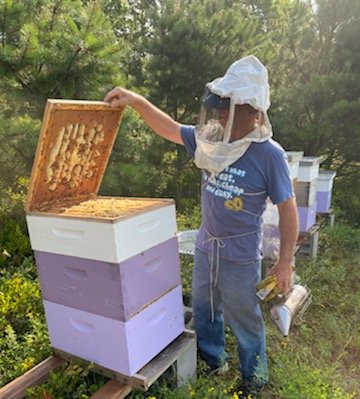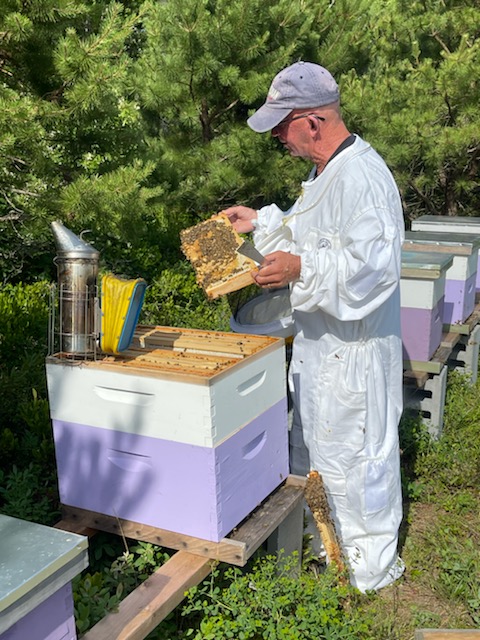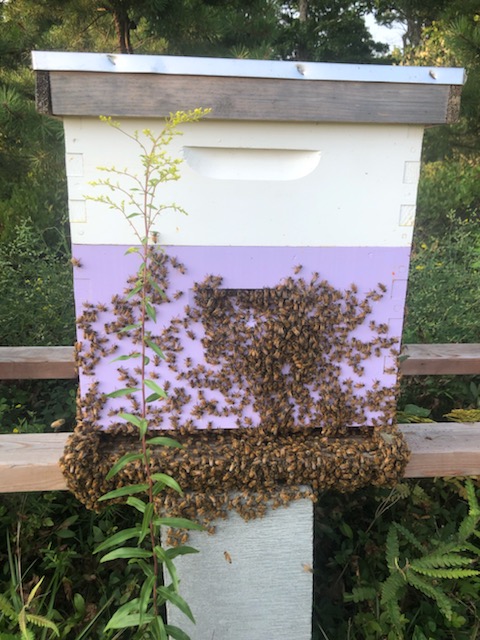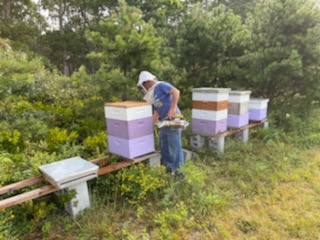East Hampton Airport Beekeeping Project Takes Flight

The East Hampton Airport has a different kind of guest taking flight since they’ve been the new home to six honeybee hives with more than 200,000 bees.
The unique addition is for a project meant to make a positive contribution to the environment and provide educational courses on the lives and impact of honeybees in the community.
The idea for the airport to have beehives came up sporadically during a company meeting at Sound Aircraft Services, who runs the airport. CFE Bernadette Ruggiero thought it would be fun to get into, so she put together a presentation to get board approval.
At first, the idea of nurturing beehives at an airport may sound a bit out of place, but Ruggiero explained that the idea is not so taboo, and that the environment may be more suitable than one would think at first glance.

“I started looking into bees and beehives [at airports] and this is an idea that’s been going around at least since the ‘90s,” says Ruggiero. “A lot of times when you set up beehives around agriculture, they are really burdened by pesticides, so a lot of honeybees have been on the decline. The airport land is really untouched nature, and we never deal with pesticides so it’s perfect for the honeybee population.”
The project fully came together in the spring when the airport reached out to Chris Kelly from Promised Land Apiaries, which is the name of his beekeeping business based on the North Fork that he’s run for more than 30 years. Kelly explained when he met with Ruggiero and president and COO Steve Tuma, they immediately hit it off, but their emphasis on providing an educational program is what really sparked Kelly’s interest to get involved.
“Educational courses are one of my passions, but in particular what really caught my eye was that they wanted to make some kids programs,” says Kelly. “I just loved that because it’s the next generation of people dealing with our environment.”
With many bee suits already on hand at the airport to be loaned for classes, the initiative for educational classes on honeybees and their hives is set for next spring, according to Kelly. They would also like to offer courses in the winter for a “crash course on beekeeping.” By having a series indoors and taking the lessons live in the spring to learn in a more hands-on environment, it seems like the perfect way to learn beyond reading facts from a textbook. Currently, these courses will be geared toward the age range of 10–18 years old.
“I think all of this is a win for the community,” says Kelly. “For a moment, just take the airport out of the equation. The way I look at the area, the airport occupies about 800 acres, that’s wide open space that has intrinsic environmental value, and that’s where I think about it from.”

In addition to the positive impact it has on the surrounding environment and educating the next generation on the importance of honeybee survival, the airport is already in the process of putting together a harvest fest for the community, set for October, where Kelly will use an 85-year-old honey extractor, the results of which will be distributed to local food pantries. The honey can also be bought at the event where the proceeds will be donated to good causes in the community.
The event is sure to be fun and educational, and the process of honey extracting actually offers a measurement for the quality of the environment and how well the bees are thriving in the surrounding area.
“Think of the honeybee hive as an environmental barometer,” says Kelly. “One is the health of the hive, how it grows, how it goes through its decline, and the second is observing how much honey and pollen they gather in that area. With the bees in the airport, the surrounding areas are fully supporting these six hives that we have.”

Over the years, East Hampton Airport has gotten a fair share of noise and pollution complaints from members of the community, but the constantly growing population of honeybees is a form of giving back to the community’s environment in a way that provides immediate and long-term benefits. To some, it can seem like a small effort toward being environmentally friendly, but the full effects of this project remain to be seen in years to come.
“I think it’s part of the discovery process of being able to start this project, because we actually don’t know the limits,” says Kelly. “I would really like to see that we get more biodiversity and biomass assessment, and I could see the East Hampton schools getting involved in that kind of science project, and to me, that would be a beautiful way of connecting the dots.”



